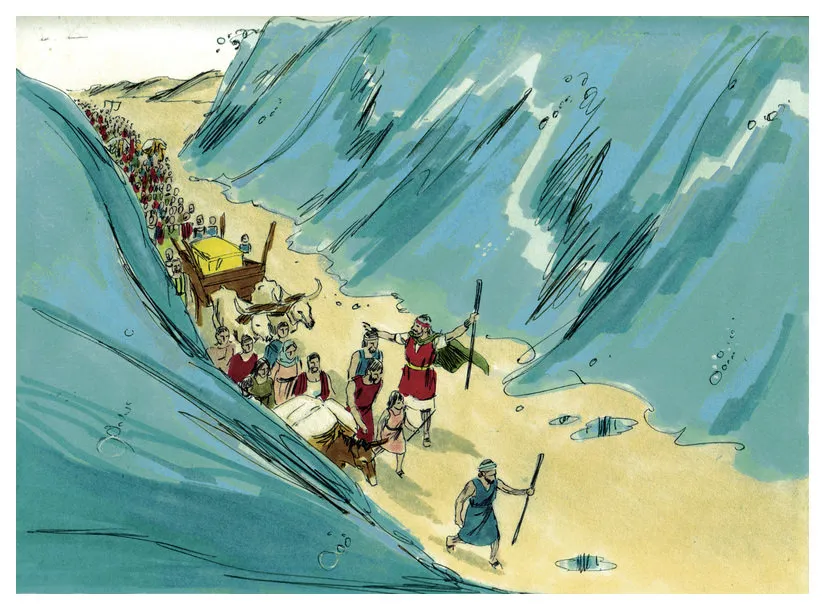The story of Naaman in the Bible is a testament to the power of faith, humility, and obedience to God. Naaman, a commander in the army of Aram, was struck by leprosy. But through a chain of events, he found himself seeking help from the prophet Elisha in Israel. What follows is an inspiring and thought-provoking journey of healing and transformation. Keep reading to uncover the lessons we can learn from Naaman’s story and the importance of obedience and gratitude in our own lives.
Naaman: The Commander with a Leprosy

Have you ever heard of Naaman in the Bible? He was a mighty commander in Aram, but unfortunately, he was struck with a skin disease called leprosy. This was a difficult and distressing time for Naaman, and he didn’t know where to turn.
One day, a servant girl from Israel who worked for Naaman’s wife told him about a prophet named Elisha who could heal him. Naaman took this advice and went on a journey to Israel to find this prophet and be cured of his leprosy.

This story teaches us about the power of faith and the importance of turning to God in times of trouble. Naaman had everything he needed in life, except for his health. He was a powerful commander, respected and feared by many, but the one thing he couldn’t control was his own body.
Sometimes, our lives can feel like they’re out of control too. We might have everything we need on the surface, but deep down, we’re struggling with something. Naaman’s story reminds us that we can always turn to God for help, no matter how big or small the problem is.
Here are some key takeaways from Naaman’s story:
-
No one is exempt from suffering
Even though Naaman was a wealthy and respected commander, he still suffered from a skin disease that affected his whole life. This shows us that no one is exempt from suffering, no matter how successful or powerful they may seem on the surface. -
Faith can lead to healing
Naaman was healed because he had faith in Elisha and in God. This is a powerful reminder for us that trusting in God and having faith can lead to healing, both spiritually and physically. -
Pride can hold us back
Naaman was reluctant to follow Elisha’s instructions at first because they didn’t seem grand enough for someone of his status. But once he put his pride aside and followed through with the simple task of bathing in the Jordan River seven times, he was healed. This reminds us that sometimes, we need to put our pride aside and take simple steps towards healing and growth.
There’s so much to learn from Naaman’s story in the Bible. Stay tuned for the next section where we’ll talk about Naaman’s journey to Israel and the Jordan River.
The Referred Prophet Elisha: The Miracle-Worker
After receiving the news from the servant girl about a prophet who could heal him, Naaman set out on a journey to find him. This prophet was Elisha, who was known to work miracles through the power of God. As soon as Naaman arrived at Elisha’s house, the prophet sent a message to him, instructing him to wash seven times in the Jordan River to be cleansed of his leprosy.
Initially, Naaman was overwhelmed by Elisha’s message because he expected the prophet to perform a miracle by laying hands on him or calling on the name of his God. However, Naaman’s servant encouraged him to follow Elisha’s instructions and wash in the Jordan River. Without any other viable options, Naaman followed their advice and went to the Jordan River, where he washed himself seven times as instructed.
As the story goes, Naaman’s flesh was restored, and his skin became young like that of a child. He was healed of his leprosy and thanked God for the miraculous transformation. Naaman immediately went back to Elisha’s house to thank him and offer a gift, but the prophet declined, saying, “As the Lord lives, before whom I stand, I will receive none” (2 Kings 5:16).
The story of Naaman and Elisha reveals the power of faith and obedience to God’s instructions. Elisha’s recommendation to Naaman to dip in the Jordan River seven times to heal his leprosy did not make sense at first. But Naaman’s servant girl, who had conveyed the message in the first place, convinced him to follow the prophet’s instructions. Sometimes, obedience requires humility, and great faith begins with small steps of obedience.
The story of Prophet Elisha also demonstrates God’s power to heal and restore people from ailments such as leprosy. Today, this account continues to inspire millions of Christians worldwide to believe in the transformative power of God, who works miracles through faith.

In conclusion, Naaman’s journey, his healing, and his encounter with Prophet Elisha teach us valuable lessons in humility, faith, and obedience. Naaman experienced God’s power and miracle because he humbly accepted Elisha’s instructions, followed them with faith and obedience, and worshipped God. The story of Naaman and Elisha remains a testament to God’s power to work miracles, heal the sick and restore the weary, even in our present-day challenges.
Naaman’s Journey to Israel and the Jordan River
Deeply embedded in the Old Testament of the Bible, the story of Naaman reveals the essence of faith, humility, and obedience. Naaman was a commander in the Aram army, who had leprosy, a dreaded and incurable disease in ancient times. Naaman became desperate and sought a cure for his ailment. Fortunately, he had a servant girl who had been captured from Israel, and she suggested that he visit the prophet Elisha in Samaria.
Naaman did not know the God of Israel, nor the prophet Elisha. However, his desperation made him willing to try anything. Despite his high status as a commander, Naaman humbly made the long journey, with an entourage of horses and chariots, bringing an enormous amount of wealth, such as silver, gold, and clothing, to offer as a gift to the prophet Elisha.
When Naaman arrived in Israel, the king of Israel, fearing a diplomatic problem arose as he did not know how to heal the commander’s leprosy. Elisha heard about this and intervened, telling the king to send Naaman to him. Naaman was shocked to see that the prophet Elisha did not even come out of his house to meet him, and instead sent a messenger to tell Naaman to wash seven times in the Jordan River.
Naaman was initially furious, as he saw the request as a simple act of humiliation from the prophet. Naaman was expecting the prophet to perform some incredible miracle to cure his leprosy. Naaman stormed away, ready to leave Israel empty-handed. However, Naaman’s servants calmed him down and reminded him that he had nothing to lose. Naaman finally consented to take a dip in the Jordan River, and he was miraculously healed from leprosy.
Naaman’s journey from desperation to hope and cure, shows the immense power of faith. Naaman had to overcome his pride and arrogance, but because of his willingness to obey God’s calling, he was cured of his debilitating disease.
« Unpacking the Theological Debate: Is Jesus God in the Flesh?
Unveiling the Connection between the Pyramids and the Bible »
Lessons from Naaman’s Journey:
- Humility: Naaman had to learn to swallow his pride and acknowledge that he was not the most powerful man in the world. He had to become humble to be able to approach the prophet Elisha to ask for a cure.
- Obedience: Naaman had to follow the instructions given by the prophet Elisha. Even though he did not understand why he needed to wash seven times in the Jordan River, he followed the instructions given to him, and was cured of leprosy.
- Faith: Naaman’s journey wouldn’t have been complete without faith. He was willing to put his faith in God, even though he was not familiar with the Israelites’ God.
Naaman’s journey to the Jordan River is a powerful reminder of the transformative power of faith. His story inspires us to be humble, obedient, and faithful to God’s calling.
The Test of Faith: Naaman’s Cleansing
After reaching the prophet Elisha’s home, Naaman was instructed to go wash himself seven times in the Jordan River in order to be cleansed of his leprosy. Initially, Naaman was skeptical of this and even felt insulted. He had doubted Elisha’s ability to heal him and that he was merely mocking him. However, Naaman’s servants encouraged him to follow through with the prophet’s instructions. Naaman, with a test of his faith, went to the Jordan River and washed himself seven times. To his surprise, he was completely healed of his disease. The once diseased commander was now clean and purified through his faith in God and obedience to the prophet’s word.
This story serves as a reminder that God’s ways are not always easy nor understandable. Sometimes, to receive healing, we must have faith and do things that seem irrational to us. Naaman could have refused to wash himself in the Jordan River and missed out on his miraculous healing. However, he trusted God’s plan and humbled himself enough to complete a task despite not fully comprehending the necessity of it.

More than just an account of miraculous healing, Naaman’s story holds lessons on the virtues of humility and obedience. His initial pride almost hindered his ability to receive healing, but he was blessed because he listened to wise counsel and acted on the faith he had. Not only did he become healthy, but he also became a better person through this experience.
Furthermore, Naaman’s gratitude towards the prophet and his faith in God also reminds us about how important it is to give thanks for what we receive. It is easy to take credit for our accomplishments and forget the blessings that come our way. Naaman’s willingness to worship God after receiving healing demonstrates that our victories should always be attributed to a higher power.
In summary, Naaman’s cleansing in the Jordan River is a testament to the power of faith in God and obedience to his commands. It is a story of humility and gratitude, of putting faith in the unseen and unknown. As Christians, we can draw inspiration from Naaman’s story and strive to emulate his virtues in our own lives. Let us be obedient, humble, and grateful, knowing that through our faith, we can receive even the most miraculous of blessings.
Lessons from Naaman’s Character: Humility and Obedience
Naaman’s story in the Bible teaches us valuable lessons about humility and obedience. Here are some important takeaways:
-
Humility is necessary for healing: Naaman’s pride almost prevented him from experiencing his miraculous healing. He was a commander and expected to be treated as such. However, when he humbly followed the instructions of the prophet Elisha, he was healed. As Christians, we must also let go of our pride and submit to God’s will in order to experience His healing and blessings.
-
Pride can blind us: Naaman initially refused to follow Elisha’s instructions because he was expecting his healing to happen in a certain way. This cost him time and added frustration, as his pride blinded him from seeing that God’s ways are higher than our ways. In the same way, our pride can prevent us from seeing the bigger picture and experiencing the fullness of God’s plan for our lives.
-
Obedience leads to blessings: When Naaman obeyed Elisha’s instructions and dipped himself in the Jordan River seven times, he was healed. His obedience led to his blessing. As Christians, we must also obey God’s commands if we want to be blessed. Obedience is not always easy, but it is always worth it in the end.
-
Gratitude is an attitude: Naaman’s attitude of gratitude is evident in his words after his healing. He declared that there was no God but the God of Israel and committed to worshiping Him alone. As Christians, we must also cultivate an attitude of gratitude and worship God for all the blessings He has given us.
-
Service should come from a place of humility: Naaman’s servant girl is a symbol of humility and service. Despite her lowly status, she was responsible for Naaman’s healing by directing him to the prophet Elisha. As Christians, we must also serve others from a place of humility and understand that no service is too small when it comes from a heart that wants to help others.

By learning from Naaman’s story, we can become better Christians and lead a life that is pleasing to God.
Naaman’s Gratitude and Worship
After Naaman was cleansed of his leprosy, he immediately felt a sense of gratitude towards God. He knew that it was only through God’s power that he was able to be healed, and as a result, he made the decision to worship God. Naaman’s story is a perfect example of how God can work in our lives and how we should respond with a heart of gratitude and worship.
Naaman’s gratitude towards God was not just reflected in his words but also in his actions. He tried to give gifts to Elisha as a way of thanking him for the miracle, but Elisha refused the gifts. Instead, Naaman proclaimed his faith in God by stating, “Now I know that there is no God in all the world except in Israel” (2 Kings 5:15). Naaman’s response was not one of obligation but of genuine gratitude and recognition of God’s power.
Moreover, Naaman’s gratitude was not just a passing moment, but it was a lasting change in his heart. He requested a pardon from God for his future service in the temple of Rimmon, which was a common practice in his homeland of Aram. Naaman wanted to live a life of worship, and he knew that he needed to fully commit himself to God to do this.
Naaman’s story teaches us several lessons about worship and gratitude. Firstly, we should recognize God’s power in our lives and give credit where credit is due. Secondly, our gratitude towards God should not just be in words but also in our actions. When we serve God, our worship should come from a heart full of thankfulness. Finally, gratitude and worship don’t just happen overnight, but they are lifelong responses that require consistent effort and commitment.

In conclusion, Naaman’s story is not just a tale of healing, faith, and humility, but it’s also a story of gratitude and worship. Naaman’s transformation showed us that when we recognize God’s power in our lives, our natural response should be one of gratitude and worship. As we continue to navigate through our own journeys of life, let us strive to have a heart of worship just like Naaman did, always giving credit to God and acknowledging God’s power in all aspects of our lives.












